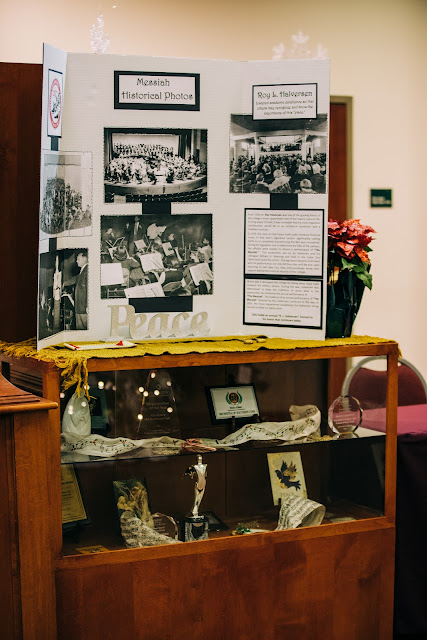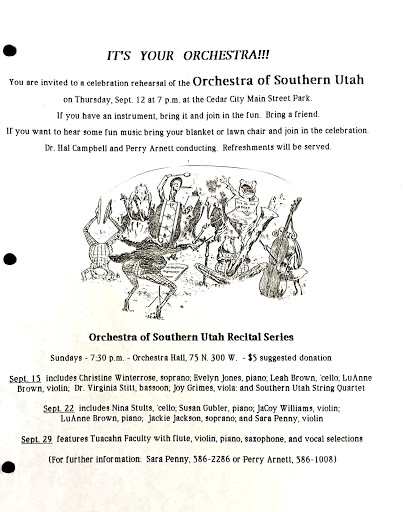Handel's Messiah Helped Save SUU (then BAC) in 1935
In celebration of #suu125 we had a display at this year’s Messiah performances. Thanks to Anne O. Leavitt and Ryan Paul for this historical documentation about how a crucial Messiah performance in 1935 helped save SUU, then BAC. Photos thanks to SUU Special Collections. Thanks to Patty Walser for creating the display. We are happy to have so many SUU faculty and students join with the community musicians for this ongoing community tradition. Thanks to everyone who participated and came this year.
Roy L. Halversen fostered academic excellence
so that others may recognize and know the importance of this place
by Ryan Paul for an SUU Convocation in 2022
In 1927 Roy joined the faculty of the Branch Agricultural College in Cedar City. He taught band,
orchestra, theory, and English. In 1929, Roy married Maude Macfarlane and went to Germany
for a year to study at the University of Berlin.
Roy returned to Cedar City in 1930, and he wasted no time becoming involved in the
community as well as the school. He created a string quartet that performed for the community
and was well received by the citizens of Cedar City.
After having experienced such decidedly different worlds over the course of his far-flung
training (which would include another year of study at Julliard in 1937), Halversen chose, quite
remarkably, to settle permanently in Cedar City. From 1930 on, he was one of the guiding
forces of the college’s music department and of the town’s cultural life. A string player himself,
it was inevitable that his most important contributions would be as an orchestral conductor and
a chamber musician.
Former Student Floyd Rigby said that “When Roy Halversen took a violin into his hands,
removed a hankie from his pocket and placed it gently under his chin and took a moment to
cradle that violin, there was a certain expression that came over his face before he would begin
to play, as though all of the music was going through his mind and each note was a personal
friend.”
In 1935, the state of Utah found itself under immense financial stress. In that year’s legislative
session significantly cutting funds to, or completely discontinuing the BAC was considered.
During the legislative visit to determine the fate of the campus, the officials were invited to
attended a performance of "The Messiah". This production, put on by Halversen and his
colleague William H. Manning and held in the Cedar City Tabernacle saved the school. The
legislators, who were very familiar with the piece deliberately choose seats next to the doors so
they would have the option to leave early. However, they became enthralled with the
performance, not only did they stay until the end, upon returning to Salt Lake City, they
enthusiastically threw their support behind the financial security of the College.
From 1937-1951, Professor Halversen served as the secretary for the Music Arts Committee.
This group was tasked with finding musical artists to come to campus and perform for the
students, including singers, piano and string quartets, Opera companies, and other musical
groups.
World War II disrupted the college by taking away many male students for military service.
However, it also brought a unit of the Air Force to campus. Halversen was appointed director of
academics for these men and oversaw the instruction of three hundred air corps cadets in the
fields of mathematics, physics, history, geography, English, medical aid, and civil aeronautics
regulations.
During the war, Halversen was determined to keep the traditions of music alive in the
community. He continued the annual performance of the Messiah, and his expertise in
orchestra music and his ability to involve the community literally preserved the musical
traditions of Cedar City during this time.
After the war, Roy Halversen continued to teach at the school and became a much-loved
professor and stalwart community member. He often played at the funerals of his friends and
neighbors, gathered groups of youth to play musical programs in local church congregations,
served in the leadership of many civic clubs and organizations, and over the course of four
decades, Halversen organized, directed, and participated in countless orchestras, string
quartets, and other ensembles. Perhaps more importantly, he shared his abilities
unstintingly—and often without compensation—with the local schools, teaching and inspiring
literally hundreds of students.
The tradition of an annual performance of "The Messiah"; fostered by Roy Halversen continues
to this day. In 2005, the music department established the Halversen String Quartet to keep his
legacy alive. The Orchestra of Southern Utah states that Halversen’s "Beliefs are the foundation
of the orchestra's beliefs, as it strives to support the youth today in their musical endeavors
and goals"; OSU holds a bi-annual "R. L. Halversen Young Artist" concert in his honor that continues today.
Roy Halversen died on March 16, 1970 after a battle with cancer. Speaking at his funeral SUSC
president Royden C. Braithwaite aptly observed that Halverson’s life’s work had really been
more of a ministry.
In a sense, then, whether he was in Utah, Berlin, or New York, Roy Halversen really inhabited a
single world—that of music. As his friend Maurice Abravanel, the renowned conductor of the
Utah Symphony, observed: “He dedicated his life to the highest calling, that of a teacher—and
he taught the most humane of all the arts, which is music. He proved by his own example that the great man can be fully productive even in a comparatively small community, and he shared his love of music with a whole generation of students who were fortunate to learn from him.”
“The years have been long,” Halversen wrote shortly before his death, “the years not easy to
maintain and much pioneering has had to be done. Certainly, a fight has been made not to
compromise the standard of music, and [... to do all] that could be done with available
material.”
Roy L. Halversen fostered academic excellence so that others may recognize and know the
importance of this "place".








Comments
Post a Comment